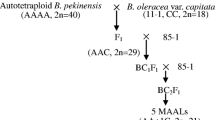Abstract
The genus Brassica consists of several hundreds of diploid and amphidiploid species. Most of the diploid species have eight, nine or ten pairs of chromosomes, known respectively as the B, C, and A genomes. Genetic maps were constructed for both B. napus and B. oleracea using mostly RFLP and RAPD markers. For the B. napus linkage map, 274 RFLPs, 66 RAPDs, and two STS loci were arranged in 19 major linkage groups and ten smaller unassigned segments, covering a genetic distance of 2125 cM. A genetic map of B. oleracea was constructed using the same set of RFLP probes and RAPD primers. The B. oleracea map consisted of 270 RFLPs, 31 RAPDs, one STS, three SCARs, one phenotypic and four isozyme marker loci, arranged into nine major linkage groups and four smaller unassigned segments, covering a genetic distance of 1606 cM. Comparison of the B. napus and B. oleracea linkage maps showed that eight out of nine B. oleracea linkage groups were conserved in the B. napus map. There were also regions in the B. oleracea map showing homoeologies with more than one linkage group in the B. napus map. These results provided molecular evidence for B. oleracea, or a closely related 2n=18 Brassica species, as the C-genome progenitor, and also reflected on the homoeology between the A and C genomes in B. napus.
Similar content being viewed by others
Explore related subjects
Discover the latest articles and news from researchers in related subjects, suggested using machine learning.Author information
Authors and Affiliations
Additional information
Received: 14 June 1996 / Accepted: 11 October 1996
Rights and permissions
About this article
Cite this article
Cheung, W., Champagne, G., Hubert, N. et al. Comparison of the genetic maps of Brassica napus and Brassica oleracea. Theor Appl Genet 94, 569–582 (1997). https://doi.org/10.1007/s001220050453
Issue Date:
DOI: https://doi.org/10.1007/s001220050453




